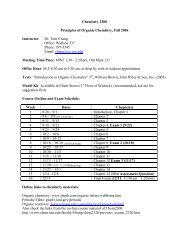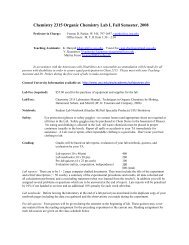Organic Chemistry II
Organic Chemistry II
Organic Chemistry II
- No tags were found...
Create successful ePaper yourself
Turn your PDF publications into a flip-book with our unique Google optimized e-Paper software.
<strong>Chemistry</strong> 2320<strong>Organic</strong> <strong>Chemistry</strong> <strong>II</strong>, Spring 2008Instructor:Dr. Bradley S. DavidsonOffice: Widtsoe 341Phone: 797-1628e-mail: davidson@cc.usu.eduMeeting Time/Place: MWF 10:30 – 11:20 am, ENGR 103; R 3:30 – 4:20 pm, ENGR 103Office Hours:Course Web Pages:Materials:Course Description:MWF, 9:00 – 10:00 am; T, 1:30 – 2:30; or by appointmentBlackboard Vista: online.uen.org/webct/entryPage.dowebctText – “<strong>Organic</strong> <strong>Chemistry</strong>” Custom Edition for USU (or 5 th Ed), Paula Bruice,Prentice Hall (2007).Study Guide and Solutions Manual by Bruice.Model Kit – Available in Chem Stores (1 st floor of Widtsoe). (recommended)The second of a two-semester sequence, covering structures, physical properties,nomenclature, mechanisms of reactions, and biological relevance of organic andbioorganic molecules.General Learning Objectives for 2320:<strong>Organic</strong> chemistry is a cumulative subject; therefore, you will be required to continuedemonstrating your knowledge and understanding of the topics covered in Chem 2310. In addition, youwill need to:• Understand what structural properties are probed by mass spectrometry, infrared spectroscopy,and ultraviolet spectroscopy, and be able to use spectral data to identify the structures of organicmolecules.• Understand the structural properties probed using nuclear magnetic resonance spectroscopy, suchas the interactions between nuclei, magnetic fields, and radiofrequency radiation, and be able tointerpret proton and carbon NMR spectra to identify the structures of organic molecules.• Be able to identify aromatic and antiaromatic compounds and appreciate the chemicalconsequences of aromaticity; be able to write the mechanisms for and predict the products ofelectrophilic aromatic substitution reactions.• Be able to explain and to predict the effects of substituents on the reactivity and regiochemistry ofelectrophilic aromatic substitution reactions.• Know the structures and chemical properties of carboxylic acid derivatives; be able to write themechanisms for nucleophilic substitution and hydrolysis reactions of such compounds, and topredict the products of such reactions.• Be able to write mechanisms for nucleophilic addition reactions and for addition-eliminationreactions of aldehydes and ketones, and be able to predict the products of such reactions.• Understand the reason for and the consequences of the acidity of protons alpha to carbonylgroups, be able to write mechanisms for the reactions of enolate anions, and predict the productsof such reactions.• Be able to identify the various forms of catalysis (including nucleophilic, general acid/base,specific acid/base, anchimeric assistance, metal-ion catalysis) and be able to write mechanisms forsuch processes.• Be able to describe the general structure of a carbohydrate, and the major reactions ofcarbohydrates.
• Be able to write the structure of an amino acid, and explain how amino acids form proteins andtheir overall chemical structure and reactivity.• Know the general structures of lipids and fatty acids and their chemical and physical properties.• Know the structures of nucleosides, nucleotides and nucleic acids, and the physical and chemicalproperties of related biological molecules.***Detailed learning objectives for each chapter are available on the Blackboard site.Tentative Course Outline and Exam Schedule:Week Dates Quiz Chapter(s)one 1/7 – 1/11 Pre Introduction, Chapter 12two 1/14 – 1/18 1 Chapters 12three 1/23 – 1/25 (1/21 no class) 2 Chapter 13four 1/28 – 2/1 Chapter 13, Exam 1 (2/1)five 2/4 – 2/8 3 Chapters 14six 2/11 – 2/15 4 Chapter 15seven 2/19 – 2/22 (2/18 no class) 5 Chapter 16eight 2/25 – 2/29 Chapter 16, Exam 2 (2/29)nine 3/3 – 3/7 6 Chapter 17ten 3/10 – 3/14 Spring Breakeleven 3/17 – 3/21 8 Chapter 17, Chapter 18twelve 3/24 – 3/28 Chapter 18thirteen 3/31 – 4/4 9 Chapters 19, Exam 3 (4/4)fourteen 4/7 – 4/11 10 Chapter 20, Chapter 21fifteen 4/14 – 4/18 Chapter 22, Chapter 26sixteen 4/21 – 4/25 11 Chapter 26, Reviewseventeen 4/30 (Wed) Final Exam (9:30 – 11:20 am)Assessment:Assessment involves measuring student progress as well as teaching effectiveness. The followingassessment strategies have been incorporated into this course.• A pre-test/post-test approach will be used to measure comprehension and teaching of importantconcepts. The pre-test will be administered through Blackboard and must be taken on your owntime. The ten multiple choice questions of the pre-test will reappear in the final, in slightly alteredform, to assess teaching and learning progress during the semester. If weaknesses are observed inspecific subject areas, teaching methods will be reevaluated. Although no formal points will beawarded, you must take the pre-test before you will be permitted to take course quizzes.• Student evaluations will be used to evaluate course/instructor strengths and weaknesses. Inaddition to the standard end-of-course evaluation, a midterm questionnaire will be circulated toassess teaching/learning strategies. Constructive suggestions are welcome anytime.
Online links to chemistry materials:The Bruice textbook website (needs access code) has tutorials, excersizes, quizzes, and amolecular gallery.www.prenhall.com/bruice/details.htmlJones and Bartlett Publishers' organic chemistry site, which has files of molecular structures, animationsof chemical mechanisms, and much more:www.jbpub.com/organic-online/webhome.htmA site with self-tests, message boards, and other helpful organic chemistry study aids:www.chemhelper.comLos Alamos Periodic Table Site:pearl1.lanl.gov/periodicExpansive lists of links for organic chemists:www.ux1.eiu.edu/~cfthb/links/researchwww.organicworldwide.netGrading Scheme:Point Distribution:Grade Breakdown:Best two out of three one-hour exams (2x100 pts)Best ten out of eleven Blackboard quizzes (10x10 pts)Comprehensive Final (200 pts)Total Points: 500 ptsThe grade received in the course is based on your performance on the exams, quizzes, andhomework. Grades are guaranteed as given below for overall percentage score on all exams. Actualgrade ranges may be curved somewhat lower, depending on the overall class average.Procedures:A, A- 89% or higherB+, B, B- 78% or higherC+, C, C- 66% or higherD+, D 53% or higher1. The format of the exams is a combination of multiple choice (30%) and fill-in (70%), where youwill be expected to draw chemical structures and explain you answers. The exams are meant totest your understanding of the topics covered in lecture, not your ability to repeat memorizedproblems. Expect some questions that require you to apply your understanding to new problems.Practice problems and past exams will be available on the Blackboard Vista site for download.They will provide the best examples of the fill-in questions.2. There will be no make-up exams. It is possible to take an exam in advance, but only with a validexcuse and prearrangement with me. If you miss an exam without prearrangement, then that willbe the exam dropped from your overall score.3. Addition mistakes or questions over exam grading should be discussed with me within one weekfollowing the return of the exam. No point adjustments will be made after this time.4. Quizzes will be offered through Blackboard Vista and must be taken on your own time. Eachquiz will be available from Monday, 10:30 am (MST), until the following Monday, 10:30 am.They will consist of ten multiple-choice questions, chosen randomly from a bank of questions.They will be open-book, with a time limit of 30 minutes, and can be taken as many times as you
















